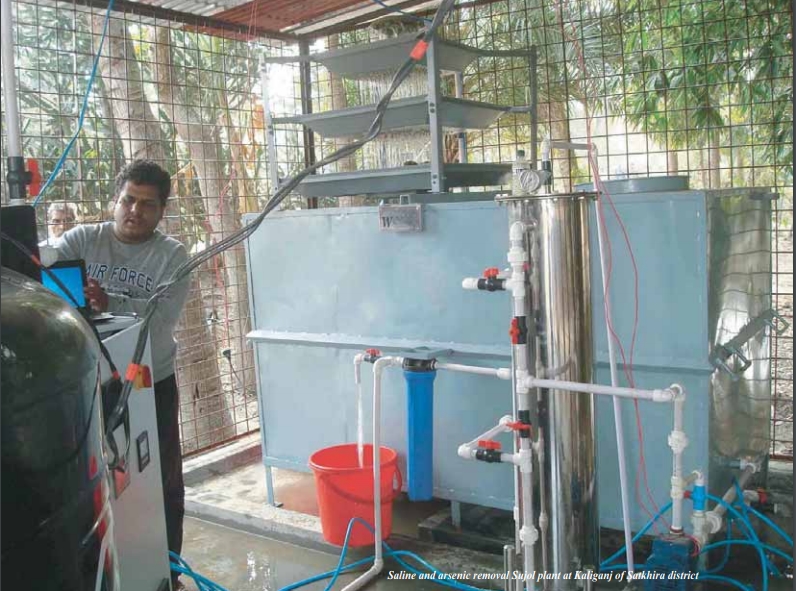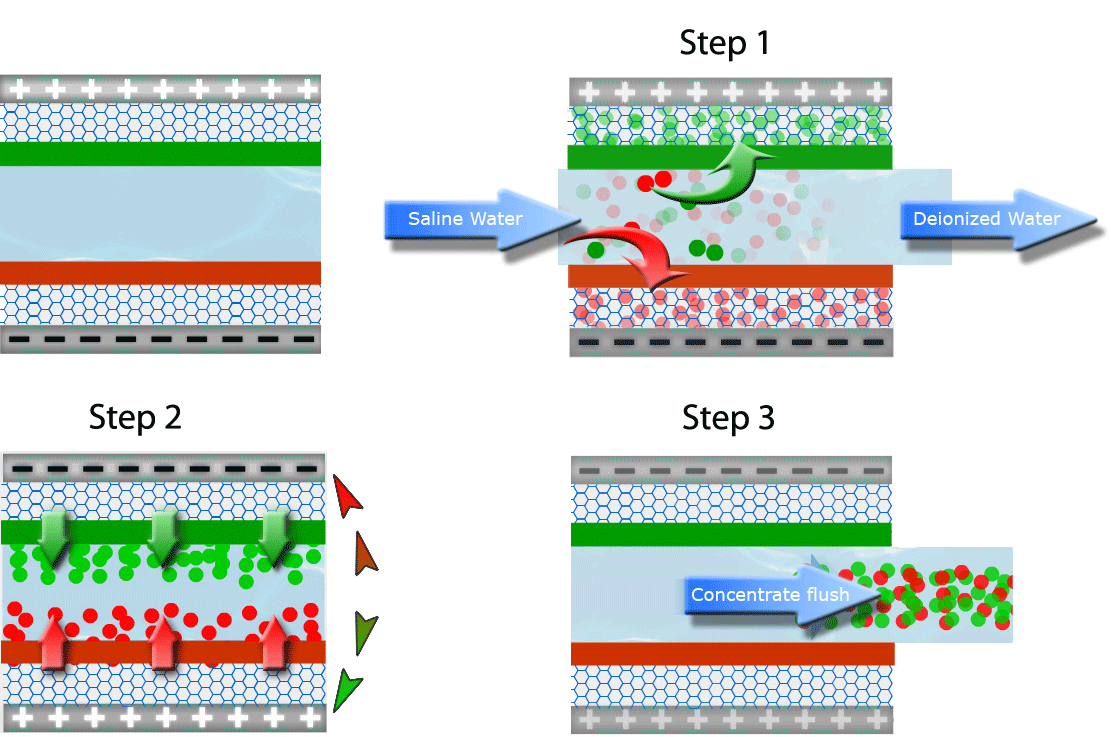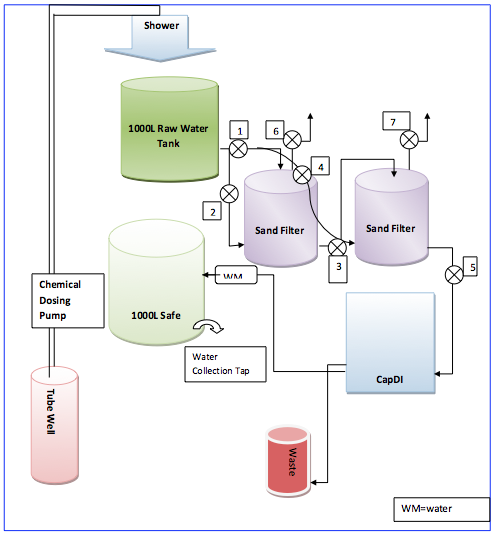Difference between revisions of "CapDI"
| (22 intermediate revisions by 4 users not shown) | |||
| Line 1: | Line 1: | ||
| − | + | [[Image:CapDi.jpg|thumb|right|200px|The CapDi project by the Ecological Management Foundation in Bangladesh. Photo: EMF]]] | |
| + | __NOTOC__ <small-title /> | ||
| + | Voltea’s award-winning desalination technology, CapDI (Capacitive deionization), is a simple and innovative way to remove dissolved salts from water with high recovery rate and low energy consumption. | ||
| − | |||
Voltea commercializes Capacitive Deionization (CapDI) in a number of applications, ranging from industrial water re-use to residential water softening. CapDI is the world’s most efficient system to desalinate brackish water. | Voltea commercializes Capacitive Deionization (CapDI) in a number of applications, ranging from industrial water re-use to residential water softening. CapDI is the world’s most efficient system to desalinate brackish water. | ||
| Line 8: | Line 9: | ||
Voltea’s CapDI technology has been recognized by numerous awards including best new technology award at the 2010 Global Water Summit, most creative company in Europe by CNBC and The Artemis Top 50 of water technology companies 2011. | Voltea’s CapDI technology has been recognized by numerous awards including best new technology award at the 2010 Global Water Summit, most creative company in Europe by CNBC and The Artemis Top 50 of water technology companies 2011. | ||
| − | == How does CapDI work? == | + | ====How does CapDI work?==== |
In CapDI, water flows through a small electrical field of 1.5 volts that is created by a pair of electrodes. Dissolved ions are pulled out of the water stream, toward the electrodes. The electrodes are separated from the water by membranes that selectively allow only positive or negative ions to pass. CapDI is effective at removing all type of ions from water (e.g. calcium, sodium, chloride, sulfate, carbonate…). | In CapDI, water flows through a small electrical field of 1.5 volts that is created by a pair of electrodes. Dissolved ions are pulled out of the water stream, toward the electrodes. The electrodes are separated from the water by membranes that selectively allow only positive or negative ions to pass. CapDI is effective at removing all type of ions from water (e.g. calcium, sodium, chloride, sulfate, carbonate…). | ||
| − | Major Steps of the CapDI Process | + | ====Major Steps of the CapDI Process==== |
| − | Step 1. Purification | + | * Step 1. Purification:<br> |
As saline water flows into the CapDI module, the oppositely charged electrodes attract the ions and pull them through the selective membranes where the ions collect on the electrodes. Clean, desalinated water flows out of the system. | As saline water flows into the CapDI module, the oppositely charged electrodes attract the ions and pull them through the selective membranes where the ions collect on the electrodes. Clean, desalinated water flows out of the system. | ||
| − | Step 2. Regeneration | + | * Step 2. Regeneration:<br> |
Once the surfaces of the electrodes become saturated with ions, they are regenerated by reversing the electrical charge of the electrodes. Since like charges repel, the ions are pushed out of the electrodes and become trapped between the membranes. | Once the surfaces of the electrodes become saturated with ions, they are regenerated by reversing the electrical charge of the electrodes. Since like charges repel, the ions are pushed out of the electrodes and become trapped between the membranes. | ||
| − | Step 3. Flushing | + | * Step 3. Flushing:<br> |
The concentrated brine between the two membranes is flushed from the system. The charge of the electrodes is returned to normal and the system is again ready to desalinate. | The concentrated brine between the two membranes is flushed from the system. The charge of the electrodes is returned to normal and the system is again ready to desalinate. | ||
| − | [[Image:capdi.png|thumb| | + | [[Image:capdi.png|thumb|none|500px|The 3-step process of water purification. Drawings: Voltea.com]] |
| − | |||
| − | |||
| − | |||
| − | == | + | ===Suitable conditions=== |
| − | High water recovery rate | + | '''High water recovery rate''' <br> |
CapDI typically recovers between 80% and 90% of the water it treats, compared to 50-70% for reverse osmosis. This is good for the environment and can save costs, both in overall water intake and in brine water discharge. | CapDI typically recovers between 80% and 90% of the water it treats, compared to 50-70% for reverse osmosis. This is good for the environment and can save costs, both in overall water intake and in brine water discharge. | ||
| − | === | + | ===Operations and Maintenance=== |
Voltea’s CapDI systems are based on a single technology platform, which allows for variable salt removal, and is scalable across water volumes ranging from a few milliliters per minute to thousands of cubic meters per hour. This | Voltea’s CapDI systems are based on a single technology platform, which allows for variable salt removal, and is scalable across water volumes ranging from a few milliliters per minute to thousands of cubic meters per hour. This | ||
flexibility means CapDI can be used in a wide array of applications, from residential white goods to large industrial cooling towers. | flexibility means CapDI can be used in a wide array of applications, from residential white goods to large industrial cooling towers. | ||
| − | |||
CapDI is the most energy efficient technology available for removing salt from brackish water. CapDI saves electricity by reusing the energy stored in the electrodes during desalination, a process similar to recharging a battery. | CapDI is the most energy efficient technology available for removing salt from brackish water. CapDI saves electricity by reusing the energy stored in the electrodes during desalination, a process similar to recharging a battery. | ||
Unlike competing desalination technologies, CapDI does not require any chemicals such as biocides or anti-scalants. | Unlike competing desalination technologies, CapDI does not require any chemicals such as biocides or anti-scalants. | ||
| − | === Test | + | ====Test Results==== |
| + | [[Image:test result.png|thumbnone|600px|Arsenic level is below Bangladesh standards its only 0.021 mg/L, but not only the As but also the others parameters Like Iron, Electrical Conductivity.]] | ||
| − | [[Image:test | + | Test Result 25 July, 2012 if we see below result (P-004)we find that capDI can remove Arsenic From water and it is below Bangladesh Standard only 0.029 mg/L and other Parameters are also within Bangladesh Standard |
| + | [[Image:test result1.png|thumb|none|600px|Test Result 25 July, 2012.]] | ||
| − | + | ===First plant set up=== | |
| + | |||
| + | [[Image:plantsetup.png|thumb|none|600px|First plant set up.]] | ||
| + | |||
| + | === Manuals, videos and links === | ||
| + | * https://voltea.com/resources-english/ | ||
| + | * http://www.voltea.com | ||
| + | |||
| + | === Company Information === | ||
| + | [[Image:voltealogo.jpg|right|200px|]] | ||
| − | |||
Voltea B.V. | Voltea B.V. | ||
| Line 57: | Line 64: | ||
+31 (0)252 200 100 | +31 (0)252 200 100 | ||
| − | + | [http://www.voltea.com/ voltea.com] | |
| − | |||
| − | |||
| − | |||
| − | |||
| − | |||
| − | |||
| − | |||
| − | |||
| − | |||
| − | |||
| − | |||
| − | |||
| − | |||
| − | |||
| − | |||
| − | |||
Latest revision as of 19:32, 12 February 2020
]Voltea’s award-winning desalination technology, CapDI (Capacitive deionization), is a simple and innovative way to remove dissolved salts from water with high recovery rate and low energy consumption.
Voltea commercializes Capacitive Deionization (CapDI) in a number of applications, ranging from industrial water re-use to residential water softening. CapDI is the world’s most efficient system to desalinate brackish water.
In 2004, Unilever scientists began evaluating CapDI as a built-in water softening device for domestic washing machines. Voltea was founded in 2006 to exploit the technology in a broader range of applications. In 2008, Voltea acquired Biosource to consolidate all relevant patents on CapDI technology in one IP portfolio.
Voltea’s CapDI technology has been recognized by numerous awards including best new technology award at the 2010 Global Water Summit, most creative company in Europe by CNBC and The Artemis Top 50 of water technology companies 2011.
How does CapDI work?
In CapDI, water flows through a small electrical field of 1.5 volts that is created by a pair of electrodes. Dissolved ions are pulled out of the water stream, toward the electrodes. The electrodes are separated from the water by membranes that selectively allow only positive or negative ions to pass. CapDI is effective at removing all type of ions from water (e.g. calcium, sodium, chloride, sulfate, carbonate…).
Major Steps of the CapDI Process
- Step 1. Purification:
As saline water flows into the CapDI module, the oppositely charged electrodes attract the ions and pull them through the selective membranes where the ions collect on the electrodes. Clean, desalinated water flows out of the system.
- Step 2. Regeneration:
Once the surfaces of the electrodes become saturated with ions, they are regenerated by reversing the electrical charge of the electrodes. Since like charges repel, the ions are pushed out of the electrodes and become trapped between the membranes.
- Step 3. Flushing:
The concentrated brine between the two membranes is flushed from the system. The charge of the electrodes is returned to normal and the system is again ready to desalinate.
Suitable conditions
High water recovery rate
CapDI typically recovers between 80% and 90% of the water it treats, compared to 50-70% for reverse osmosis. This is good for the environment and can save costs, both in overall water intake and in brine water discharge.
Operations and Maintenance
Voltea’s CapDI systems are based on a single technology platform, which allows for variable salt removal, and is scalable across water volumes ranging from a few milliliters per minute to thousands of cubic meters per hour. This flexibility means CapDI can be used in a wide array of applications, from residential white goods to large industrial cooling towers.
CapDI is the most energy efficient technology available for removing salt from brackish water. CapDI saves electricity by reusing the energy stored in the electrodes during desalination, a process similar to recharging a battery. Unlike competing desalination technologies, CapDI does not require any chemicals such as biocides or anti-scalants.
Test Results
Test Result 25 July, 2012 if we see below result (P-004)we find that capDI can remove Arsenic From water and it is below Bangladesh Standard only 0.029 mg/L and other Parameters are also within Bangladesh Standard
First plant set up
Manuals, videos and links
Company Information
Voltea B.V.
Wasbeekerlaan 24
2171 AE Sassenheim
The Netherlands
+31 (0)252 200 100






